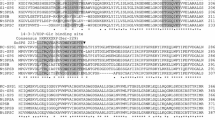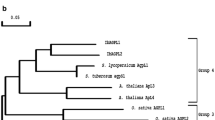Abstract
We isolated a cDNA encoding a DNA-binding protein, SPF1, of sweet potato that binds to the SP8a (ACTGTGTA) and SP8b (TACTATT) sequences present in the 5′ upstream regions of three different genes coding for sporamin and β-amylase of tuberous roots. SPF1 comprises 549 amino acids and is enriched in both basic and acidic residues. The amino acid sequence of SPF1 shows no significant homology to any known protein sequences, suggesting that it may represent a new class of DNA-binding protein. Binding studies with 35S-labeled SPF1, synthesized in vitro, and synthetic DNA fragments indicated that, although SPF1 binds to both the SP8a and SP8b sequences, it binds much more strongly to SP8a than to SP8b. SPF1 bound to the SP8a sequence as a monomer. The DNA-binding domain of SPF1 was localized within the C-terminal half of this protein, and a 162-amino acid fragment of SPF1 (Met310-Arg472) showed DNA-binding activity with no change in target sequence specificity. This fragment contains a region enriched in basic amino acids adjacent to a highly acidic stretch. A sequence which is highly homologous to a 40-amino acid sequence in the basic region of the DNA-binding domain is duplicated in the N-terminal part of SPF1. The gene coding for SPF1 is present in one or a few copies per haploid genome and the SPF1 mRNA was detected in leaves, stems and tuberous roots of the sweet potato, in addition to petioles. The level of SPF1 mRNA in the petioles decreased when leaf-petiole cuttings were treated with sucrose to induce accumulation of sporamin and β-amylase mRNAs.
Similar content being viewed by others
References
Churchill MEA, Travers AA (1991) Protein motifs that recognize structural features of DNA. Trends Biochem Sci 16:92–97
Dehesh K, Hung H, Tepperman JM, Quail PH (1992) GT-2: a transcription factor with twin autonomous DNA-binding domains of closely related but different target sequence specificity. EMBO J 11:4131–4144
Erickson AH, Blobel G (1983) Cell-free translation of messenger RNA in a wheat germ system. Methods Enzymol 96:38–50
Harrison SC (1991) A structural taxonomy of DNA-binding domains. Nature 353:715–719
Hattori T, Nakamura K (1988) Genes coding for the major tuberous root protein of sweet potato: identification of putative regulatory sequence in the 5′ upstream region. Plant Mol Biol 11: 417–426
Hattori T, Yoshida N, Nakamura K (1989) Structural relationship among the members of a multigene family coding for the sweet potato tuberous root storage protein. Plant Mol Biol 13: 563–572
Hattori T, Nakagawa S, Nakamura K (1990) High-level expression of tuberous root storage protein genes of sweet potato in stems of plantlets grown in vitro on sucrose medium. Plant Mol Biol 14:595–604
Hattori T, Fukumoto H, Nakagawa S, Nakamura K (1991) Sucrose-induced expression of genes coding for tuberous root storage protein, sporamin, of sweet potato in leaves and petioles. Plant Cell Physiol 32: 79–86
Hope IA, Struhl K (1985) GCN4 protein, synthesized in vitro, binds HIS3 regulatory sequences: implications for general control of amino acid biosynthetic genes in yeast. Cell 43:177–188
Ishiguro S, Nakamura K (1992) The nuclear factor SP8BF binds to the 5′-upstream regions of three different genes coding for major proteins of sweet potato tuberous roots. Plant Mol Biol 18:97–108
Ishiguro S, Tanaka M, Kojimoto A, Kato M, Iwabuchi M, Nakamura K (1993) A nuclear factor that binds to a dyad symmetric sequence with CGTCA motif in the 5′-upstream region of sweet potato β-amylase gene. Plant Cell Physiol 34:567–576
Kyte J, Doolittle RR (1982) A simple method for displaying the hydropathic character of a protein. J Mol Biol 157:105–132
Nakamura K, Ohto M, Yoshida N, Nakamura K (1991) Sucrose-induced accumulation of β-amylase occurs concomitant with the accumulation of starch and sporamin in leaf-petiole cuttings of sweet potato. Plant Physiol 96:902–909
Ohto M, Nakamura-Kito K, Nakamura K (1992) Induction of expression of genes coding for sporamin and β-amylase by polygalacturonic acid in leaf-petiole cuttings of sweet potato. Plant Physiol 99:422–427
Sambrook J, Fritsch EF, Maniatis T (1989) Molecular cloning: a laboratory manual, 2nd edn. Cold Spring Harbor Laboratory Press, Cold Spring Harbor, New York
Singh H, Clerc RG, LeBowitz JH (1989) Molecular cloning of sequence-specific DNA binding proteins using recognition site probes. BioTechniques 7:252–261
Struhl K (1989) Helix-turn-helix, zinc-finger, and leucine-zipper motifs for eukaryotic transcriptional regulatory proteins. Trends Biochem Sci 14:137–140
Yoshida N, Hayashi K, Nakamura K (1992) A nuclear gene encoding β-amylase of sweet potato. Gene 120:255–259
Author information
Authors and Affiliations
Additional information
Communicated by R. G. Hermann
Rights and permissions
About this article
Cite this article
Ishiguro, S., Nakamura, K. Characterization of a cDNA encoding a novel DNA-binding protein, SPF1, that recognizes SP8 sequences in the 5′ upstream regions of genes coding for sporamin and β-amylase from sweet potato. Molec. Gen. Genet. 244, 563–571 (1994). https://doi.org/10.1007/BF00282746
Received:
Accepted:
Issue Date:
DOI: https://doi.org/10.1007/BF00282746




